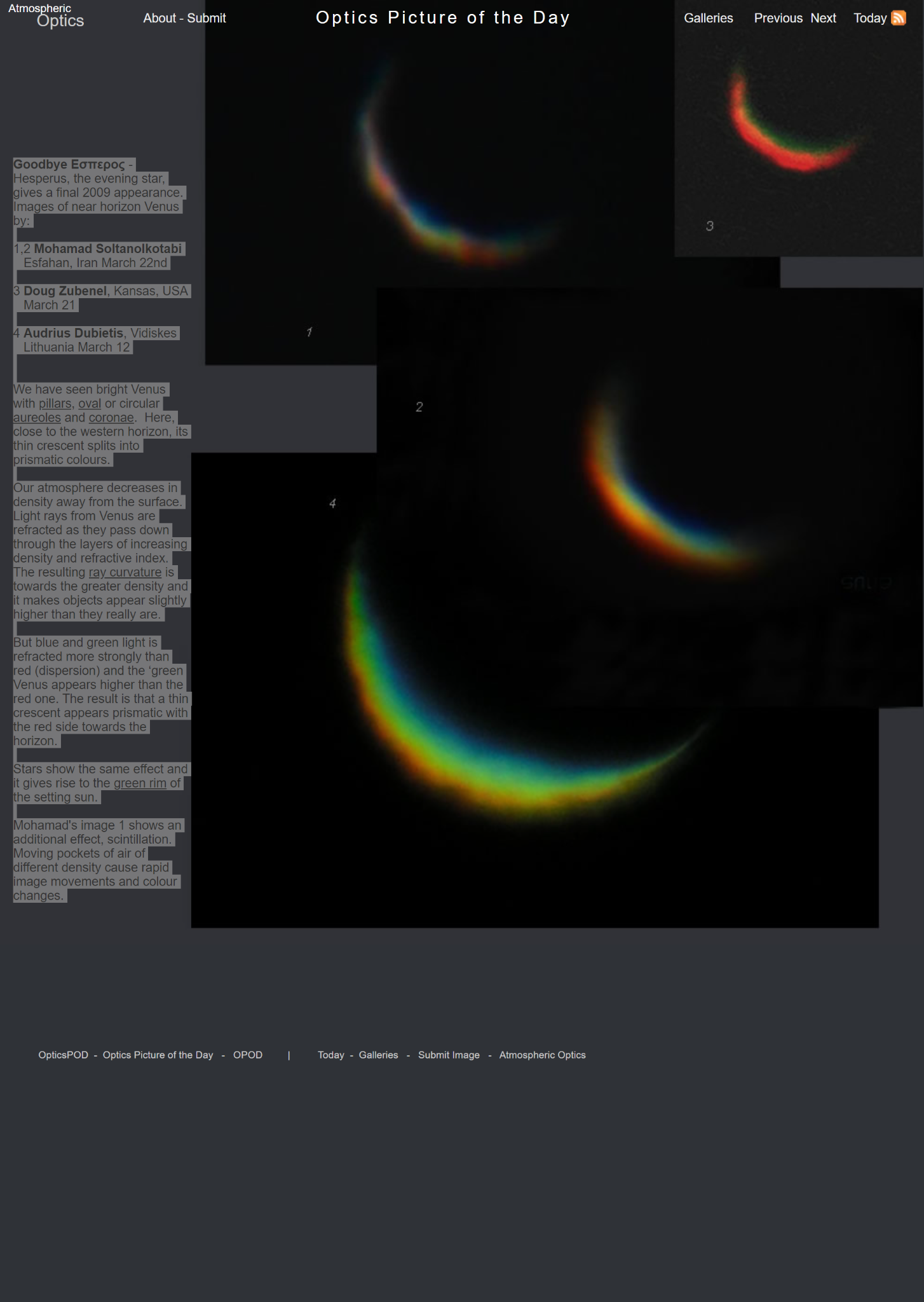Goodbye Hesperus
Goodbye Hesperus: Exploring the Phenomenon of Prismatic Venus
In the enchanting realm of atmospheric optics, one celestial beauty that captivates stargazers is the evening star, Hesperus. As the year 2009 drew to a close, this celestial wonder bid us farewell with its final appearance. Numerous photographers around the world skillfully captured images of Venus, the evening star, as it graced the near horizon with its ethereal presence.
Venus Unveiled: A Kaleidoscope of Colors
The images of Venus taken by Mohamad Soltanolkotabi in Esfahan, Iran on March 22nd, Doug Zubenel in Kansas, USA on March 21st, and Audrius Dubietis in Vidiskes, Lithuania on March 12th unveiled the mesmerizing spectacle of this celestial body. What caught the attention of astute observers were the pillars, oval or circular aureoles, and coronae that surrounded the radiant Venus. However, it was in close proximity to the western horizon that the true magic unfolded. The thin crescent of Venus splintered into a dazzling display of prismatic colors.
The Refractive Dance: Unveiling the Role of Our Atmosphere
To comprehend the enchanting phenomenon observed during the farewell appearance of Hesperus, we must delve into the workings of our atmosphere. As we ascend from the surface, the density of our atmosphere gradually diminishes. When light rays from Venus traverse these layers of increasing density and refractive index, they experience refraction—a bending of their path. This refraction is influenced by the difference in density between each layer.
Illusionary Heights: The Curvature of Light Rays
The curvature induced by refraction causes objects to appear slightly higher than their actual position. However, it is important to note that different wavelengths of light are refracted to varying degrees. Blue and green light, known for their shorter wavelengths, undergo stronger refraction compared to red light. This phenomenon, known as dispersion, manifests in the heavens as a remarkable sight—the green Venus appearing higher than its red counterpart. Consequently, the thin crescent of Venus appears prismatic, with the red side gracefully embracing the horizon.
Stars Join the Spectacle: The Green Rim of the Setting Sun
Interestingly, stars also partake in this celestial dance, contributing to the phenomenon of the green rim that graces the setting sun. Just as Venus showcases its vibrant colors, stars exhibit a similar effect. The disparity in refraction between different wavelengths of light engenders this enchanting spectacle that leaves viewers in awe.
Scintillation: Nature's Dance of Light and Air
Mohamad's image 1 offers us a glimpse into an additional effect that amplifies the enchantment—the phenomenon of scintillation. As pockets of air with varying densities traverse the path of light, they create a mesmerizing dance of rapid image movements and color changes. This interplay between light and air adds an element of dynamism to the already captivating display.
In Conclusion
As we bid farewell to Hesperus, the evening star, we are left with a profound appreciation for the intricate workings of our atmosphere and the ethereal beauty it unveils. The prismatic colors exhibited by Venus as it nears the horizon, along with the green rim adorning the setting sun, remind us of the harmonious dance between light and atmospheric conditions. These celestial phenomena continue to ignite our curiosity and inspire us to explore the wonders that lie beyond our terrestrial realm.

Goodbye Eσπερος - Hesperus, the evening star, gives a final 2009 appearance. Images of near horizon Venus by:
1,2 Mohamad Soltanolkotabi
Esfahan, Iran March 22nd
3 Doug Zubenel, Kansas, USA
March 21
4 Audrius Dubietis, Vidiskes
Lithuania March 12
We have seen bright Venus with pillars, oval or circular aureoles and coronae. Here, close to the western horizon, its thin crescent splits into prismatic colours.
Our atmosphere decreases in density away from the surface. Light rays from Venus are refracted as they pass down through the layers of increasing density and refractive index. The resulting ray curvature is towards the greater density and it makes objects appear slightly higher than they really are.
But blue and green light is refracted more strongly than red (dispersion) and the ‘green Venus appears higher than the red one. The result is that a thin crescent appears prismatic with the red side towards the horizon.
Stars show the same effect and it gives rise to the green rim of the setting sun.
Mohamad's image 1 shows an additional effect, scintillation. Moving pockets of air of different density cause rapid image movements and colour changes.
Note: this article has been automatically converted from the old site and may not appear as intended. You can find the original article here.
Reference Atmospheric Optics
If you use any of the definitions, information, or data presented on Atmospheric Optics, please copy the link or reference below to properly credit us as the reference source. Thank you!
-
<a href="https://atoptics.co.uk/blog/goodbye-hesperus/">Goodbye Hesperus</a>
-
"Goodbye Hesperus". Atmospheric Optics. Accessed on April 20, 2024. https://atoptics.co.uk/blog/goodbye-hesperus/.
-
"Goodbye Hesperus". Atmospheric Optics, https://atoptics.co.uk/blog/goodbye-hesperus/. Accessed 20 April, 2024
-
Goodbye Hesperus. Atmospheric Optics. Retrieved from https://atoptics.co.uk/blog/goodbye-hesperus/.